Short Guide to Carving Tool Terminology
Aside from cosmetic differences in handles, and of course differences and preferences in brand, the standard sizes and shapes of carving tools have been the same for about 200 years. There are three criteria in defining a caving tool: the shape of the tool shank, the width of the tool at the cutting edge, and the profile of the cutting edge.
(For brand differences between Two Cherries and Ashley Iles click here).
The Shape of the Tool
 It
can be straight,
It
can be straight,
 Have
a gentle curve going the length of the steel shank (long bent or curved).
Have
a gentle curve going the length of the steel shank (long bent or curved).
 A
pronounced curve, like a spoon at the end of the tool, with the cutting
edge on the convex side of the bend (front bent or spoon).
A
pronounced curve, like a spoon at the end of the tool, with the cutting
edge on the convex side of the bend (front bent or spoon).
 Similar
to the front bent gouge, except the bend is the other way, with the cutting
edge on the concave side of the bend (back bent).
Similar
to the front bent gouge, except the bend is the other way, with the cutting
edge on the concave side of the bend (back bent).
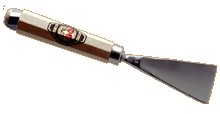 Most
tools are widest at their cutting edge and have a gentle progression from
edge to tang. An older design, which some carvers like because it gives
them more access, has the cutting edge flaring out from the shank. These
tools are called spade or fishtail tools.
Most
tools are widest at their cutting edge and have a gentle progression from
edge to tang. An older design, which some carvers like because it gives
them more access, has the cutting edge flaring out from the shank. These
tools are called spade or fishtail tools.
Cutting edges
The cutting edge is defined by two things: the width of the blade at the cutting edge and the shape of the cutting edge. The rule of thumb is that wider tools work faster. The shape or profile of the cutting edge is harder to describe.
 If
the blade is flat with no curvature it is called a chisel or a firmer chisel.
Carving chisels are ground differently from bench chisels used in cabinetmaking.
These chisels are usually beveled on both sides of the blade.
If
the blade is flat with no curvature it is called a chisel or a firmer chisel.
Carving chisels are ground differently from bench chisels used in cabinetmaking.
These chisels are usually beveled on both sides of the blade.
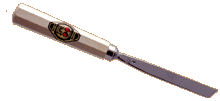 If
the blade is flat and cut at an angle to the tool it is called a skew
or corner chisel.
If
the blade is flat and cut at an angle to the tool it is called a skew
or corner chisel.
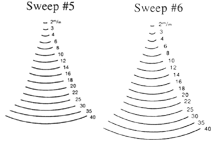 The
most common carving tools are gouges - chisels with some sort of curvature
to them. Gouges come in a vast variety of curvatures, from nearly straight
to a very tight arc. This is in addition of the overall width of the tool.
You can have, for example, a 12mm gouge of a very shallow arc or a different
12mm gouge with a very pronounced arc. The term for defining these arcs
is called "sweep" and the sweeps range from #1 which is a straight chisel
to #11 which is almost a semi-circle of the diameter of the width. We have
divided up the listings for individual gouges by sweep and each category
is illustrated by a diagram showing the curvature of the tools. In theory
the sweeps are standard but in fact each maker's sweeps might vary. For
example European sweep numbers are usually one sweep greater then the equivalent
English sweep. So, for example, an English made #5 sweep 1/2" Ashley
Iles is equivalent to a German made Two Cherries #6 sweep 12mm gouge. Most
people usually stick with one brand or another so this isn't normally a
problem, but it you decide to mix and match it's a point worth knowing.
The
most common carving tools are gouges - chisels with some sort of curvature
to them. Gouges come in a vast variety of curvatures, from nearly straight
to a very tight arc. This is in addition of the overall width of the tool.
You can have, for example, a 12mm gouge of a very shallow arc or a different
12mm gouge with a very pronounced arc. The term for defining these arcs
is called "sweep" and the sweeps range from #1 which is a straight chisel
to #11 which is almost a semi-circle of the diameter of the width. We have
divided up the listings for individual gouges by sweep and each category
is illustrated by a diagram showing the curvature of the tools. In theory
the sweeps are standard but in fact each maker's sweeps might vary. For
example European sweep numbers are usually one sweep greater then the equivalent
English sweep. So, for example, an English made #5 sweep 1/2" Ashley
Iles is equivalent to a German made Two Cherries #6 sweep 12mm gouge. Most
people usually stick with one brand or another so this isn't normally a
problem, but it you decide to mix and match it's a point worth knowing.
Once you get past the gouges the landscape simplifies
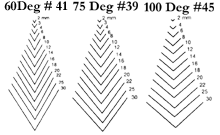 There are "V" tools of different angles
There are "V" tools of different angles
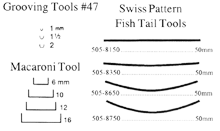 As
a gouge gets increasingly curved it eventually is greater than a semi-circle.
These tools are called "veiners" or "grooving tools" and are primarily used
in smaller sizes for detailing. Macaroni tools are rectagular, and we also
carry the fishtail tools in the specialty depeartment.
As
a gouge gets increasingly curved it eventually is greater than a semi-circle.
These tools are called "veiners" or "grooving tools" and are primarily used
in smaller sizes for detailing. Macaroni tools are rectagular, and we also
carry the fishtail tools in the specialty depeartment.
|
Hours: M-F 9:00-5:00, closed Sat,Sun Our Guarantee & Return Policy Shipping and Sales Tax Info Privacy Policy Holiday Calendar |
|
Contact Us:
Email: support@toolsforworkingwood.com Phone: 800-426-4613 or 718-499-5877 Visit Us in Brooklyn: Directions to Our Showroom © 1999-2019 toolsforworkingwood.com Powered by 01 Inc. Coded entirely in NYC |


